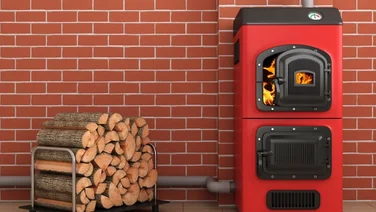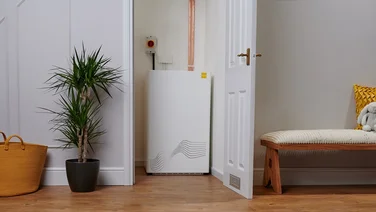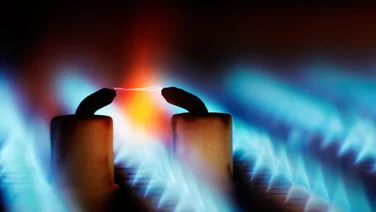We receive a small fee from trusted installers when you request a quote through our site. This helps us keep our content independent, well-researched and up to date – Learn more
✔ A room thermostat and valves can save you £75–£155 per year
✔ These controls can help you keep your house at the right temperature
✔ Fill in the form above to receive bespoke boiler quotes
Most of us aren’t experts in how a boiler works, but knowing the basic ins and outs of a boiler can help you get the most out of it and save you money.
A boiler costs money, after all, so by treating it right, you’ll reduce the risk of having to pay for repairs or a replacement, and you might save on your energy bills.
There are many questions you might be asking yourself. For instance, why do you have a thermostat in your hallway, a thermostat on your boiler, and thermostatic valves on your radiator? Don’t these things work against each other?
While your house’s central heating and hot water network might seem complex, it’s actually rather simple.
On this page, we’ll explain the typical controls associated with central heating and hot water, including tips on the optimum settings for high efficiency.
If you’d like to receive free boiler quotes, pop a few details in our easy-to-use tool, and we’ll put you in touch with installers in the area. This way, you’ll find the best deal for your property.

Why do you need a thermostat for your boiler?
The thermostat is an essential part of the boiler system.
A boiler thermostat is essentially a switch which is turned on and off by changes in temperature in the room.
The main thermostat is an essential component of the central heating system. Without it you would have to turn your heating on and off multiple times a day.
It’s important to remember that the thermostat is reacting to the temperature in the room, not in the boiler.
If you set your thermostat to 18°C on a hot day, there’s a good chance the heating won’t come on at all, as the outside temperature is doing all the work. At other times, your thermostat will turn the heating on and off as the temperature drops and rises in the home.
Since 2018, it’s been a legal requirement in the UK for all new boilers to include time and temperature controls. It’s called the Boiler Plus legislation, and applies to all gas and oil boiler installations.
However, according to the National Energy Foundation (NEF), more than two thirds of households in Britain have boilers that wouldn’t meet the new minimum legal standards.
If you need a new boiler, find out how much a new boiler might cost you here.
How does a boiler thermostat work?
Your boiler has two jobs: 1) to supply hot water to your radiators, and 2) to supply hot water to your showers and taps.
It makes sense, then, that you’d have temperature controls for each of these two functions. This is why a ‘boiler thermostat’ essentially encompasses two sub-thermostats.
But where can you find them, and what do they look like? It depends on what type of boiler you have.
Heat-only boilers:
- These come in two types, conventional and system
- They have a hot water cylinder that is responsible for supplying your showers and taps
- They have a central heating thermostat (which you can find on the main boiler unit) and a hot water cylinder thermostat (which you can find on the cylinder itself, near the bottom)
- Both thermostats look like small dials with a range of temperature options in a circle
Combi boilers:
- They take water directly from the mains and heat it instantly
- They combine the functions of a cold water storage tank and a hot water cylinder in one small unit
- They have two dials on the main unit – one for the temperature of the radiators and one for the temperature of the hot water
- If you’ve got a modern combi boiler, it’s likely your ‘dials’ will actually be a digital display with buttons
The importance of location
It’s also important to take into account the location of the thermostat when installing a boiler.
The thermostat is usually located somewhere in the middle of the home, like a hallway, or it can be in the main living room of the house, where you spend most of their time.
However, beware of placing it somewhere overly warm, like a room that gets a lot of sunlight, or that contains a washer/dryer, since you might find that the central heating never turns on.
On the other hand, placing the thermostat somewhere cool, like a porch, might keep the heating on constantly, even if the temperature in other areas is well over your desired temperature.
That’s why it’s best to place the boiler thermostat in a location that accurately reflects the temperature of your house.
Boiler and central heating controls explained
In addition to the boiler thermostat, there are other devices that work with the boiler thermostat to give full control over the central heating and hot water. These include:
- Room thermostat
- Boiler timer
- Thermostatic radiator valves (TRVs)
- Smart heating controls
Let’s go into each one in a little more detail about each.
How does a room thermostat work?
While a boiler thermostat is situated close to the action, a room thermostat is a little more distant.
It should be located on a wall in a room where you spend a lot of time, such as your living room, and – crucially – not near your boiler.
It uses a sensor to monitor the temperature of your home, and consequently it keeps an eye on what your boiler is up to. If your room thermostat senses that your home has reached its target temperature, it will switch the central heating off. Once the temperature drops, it’ll fire up the boiler again.
Without a room thermostat to help it, your boiler would just keep pumping hot water through your radiators without really knowing when it should stop. In fact, it wouldn’t stop.
Room thermostats are either analogue or digital. While analogue thermostats are useful for elderly homeowners who rely on simple technology, digital thermostats are much more accurate and look nicer on your wall.
It’s recommended that you set your room thermostat’s daytime temperature to around 19-20°C, while at nighttime 16-19°C is adequate.
Using a boiler timer
All boilers come with an electronic timer, which enables you to programme your boiler to turn on at specific times in the day. You can decide when your boiler turns on and for how long, with most homeowners typically programming their boiler to turn on for a while in the morning and a while in the evening.
Despite what some people think, it isn’t true that boilers work best if they’re left on all the time. If you live in a home with decent insulation, you can have a bit of heat in the morning, leave your home to cool down gradually throughout the day (while you’re at work), and then set your heating to come on about an hour before you get home.
More advanced electronic timers have a seven-day function, which enables you to set different instructions for your boiler during weekends.
Some boilers – especially combi boilers – also have a mechanical timer. This timer is usually a round dial with a 24-hour clock face printed in the middle. Each hour of the day is broken into 15-minute slots, and there are little grey notches for each 15-minute slot. If you want a burst of heat outside of your boiler’s usual programming, you just pull the relevant notches down.
Using thermostatic radiator valves
While your boiler thermostat and room thermostat are ways to control the temperature of your entire home (and hot water), thermostatic radiator valves (TRVs) allow you to manage the temperature of individual rooms.
TRVs are those nozzles located on the bottom of radiators, usually with numbers 1-5 and an asterisk (*) on them. The higher the number, the greater the flow of hot water running through the radiator, and so the more heat the radiator will give off.
It’s recommended that you set your TRVs to number 3, which is about 20°C, although any bedroom radiators should be slightly cooler, set to number 2.
It’s not recommended that you have a TRV on the radiator in the same room as your thermostat, as a tampered radiator will mislead the thermostat and consequently mess up your central heating.
Using smart heating controls
Smart heating controls do everything that conventional controls do, but are connected to the internet and offer more functionality.
Some of the features they can offer include:
- Time and temperature controls with user friendly interfaces, making it easier to check and change the on/off periods for heating and hot water
- Turn the system on or off and change the temperature using your smartphone when you’re not at home
- Learning your habits and automatically adjusting controls to match
- Load compensation and weather compensation
Another advantage is that once the system has been set up, it requires very little input from you.
Whether smart heating controls will save you money will depend on your lifestyle and how you currently control your heating.

What’s the best temperature for a boiler thermostat?
Generally speaking, it’s recommended that you set your radiators to 75°C (no higher than 80°C) and your hot water to 60°C (no higher than 65°C).
If you set your hot water to anything below 60°C, you risk contracting Legionnaires’ disease. If the water in your cylinder isn’t hot enough, bacteria can grow and put your health at risk. 60°C is too toasty for bad bacteria, and not too scalding for you.
As you’ve probably observed, your tap/shower water should always be a lower temperature than your radiators.
Meanwhile, we recommend that you set the temperature of your room thermostat to around 19-20°C, and your thermostatic radiator valves to number 3.
Top tips for using boiler controls and thermostats
UK energy prices have gone down since the start of the energy crisis, but that doesn’t mean shouldn’t still try to keep your energy bills down.
Here are a few quick tips for saving money and for using your boiler controls as effectively and efficiently as possible:
- Place your room thermostat away from your boiler, away from a radiator with a TRV, and ensure it’s unobstructed by furniture
- Programme your boiler to come on in the morning and the evening; it doesn’t need to be on in the daytime
- Make sure you don’t set your hot water temperature any lower than 60°C, otherwise you risk contracting Legionnaires’ disease
- Turn down your heating by just 1°C to save around £80-85 each year (according to the Energy Saving Trust)
- Set your TRVs to number 3, but set your bedroom TRVs to number 2
- Set your room thermostat to 19-20°C, but no lower than 16°C for households with elderly people in
If your boiler seems to be on the verge of conking out, we can help you find reliable replacements for a good price. Simply pop your details in this quick form, and our professional installers will give you a call. Happy heating!








